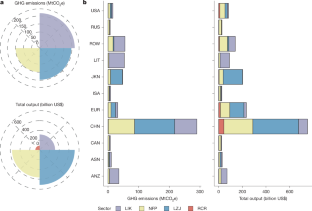Report on Decarbonization of the Lithium-Ion Battery Supply Chain and Alignment with Sustainable Development Goals (SDGs)
Introduction: Context and Relevance to Global Goals
The global lithium-ion battery supply chain is fundamental to achieving worldwide decarbonization targets, directly supporting Sustainable Development Goal 7 (Affordable and Clean Energy) and SDG 13 (Climate Action). However, the geographically fragmented nature of its production stages introduces significant complexities for sustainable carbon management. This report summarizes an analysis of decarbonization pathways for this critical supply chain, utilizing a lithium cycle computable general equilibrium (LCCGE) model that integrates life-cycle thinking with global economic dynamics.
Key Findings: A Value-Emission Paradox
The analysis reveals a significant ‘value–emission paradox’ across the supply chain, highlighting a misalignment between economic value generation and environmental impact. This paradox presents a direct challenge to achieving SDG 8 (Decent Work and Economic Growth), which aims to decouple economic growth from environmental degradation, and SDG 12 (Responsible Consumption and Production).
Distribution of Economic Value vs. Emissions
- Upstream Mining: This stage accounts for a disproportionately high share of environmental impact, generating 38.52% of total supply chain emissions while contributing only 18.78% of the economic value.
- Downstream Cathode Production: This stage demonstrates greater economic efficiency, generating 42.56% of the total value from a lower share of 34.82% of emissions.
Analysis of Decarbonization Strategies
A comprehensive scenario analysis was conducted to evaluate various decarbonization strategies, focusing on their potential to reduce global emission intensity and advance climate objectives.
Effectiveness of Circular Economy Models
- Consumer-Oriented Recycling: While beneficial, this strategy alone is insufficient for deep decarbonization. It is projected to reduce global emission intensity by 16.30% by 2060. This approach directly contributes to SDG 12 by promoting circularity.
- Integrated Strategies: A synergistic approach combining multiple levers proves far more effective, demonstrating the need for holistic policy frameworks that align with SDG 9 (Industry, Innovation, and Infrastructure).
Optimal Pathway: Synergies of Global Collaboration and Local Adaptation
The analysis concludes that the most effective pathway for decarbonization relies on a combination of international cooperation and tailored domestic policies, a core principle of SDG 17 (Partnerships for the Goals).
Maximum Global Emission Reduction
- The highest potential global emission reduction, calculated at 35.87%, is achieved by integrating cross-regional cooperation on technology and trade with regionally adapted circular economy policies.
Regional Impact of Integrated Strategies
This synergistic approach yields substantial emission reductions in key manufacturing economies, demonstrating its effectiveness on a regional scale:
- China: Potential emission reduction of 42.35%
- USA: Potential emission reduction of 39.14%
- European Union: Potential emission reduction of 37.28%
Conclusion and Policy Blueprint
This work provides a strategic blueprint for decarbonizing complex global supply chains in alignment with the Sustainable Development Goals. By identifying the synergies between environmental, technological, and trade levers, the findings establish a framework for sustainability analysis. The report underscores that achieving global climate targets requires both global collaboration and localized adaptation, ensuring a just and sustainable transition to a low-carbon economy.
Analysis of Sustainable Development Goals in the Article
1. Which SDGs are addressed or connected to the issues highlighted in the article?
The article on decarbonizing the lithium-ion battery supply chain addresses several interconnected Sustainable Development Goals (SDGs). The primary focus on carbon management and sustainable industrial practices links directly to goals concerning climate action, responsible production, industry innovation, and global partnerships.
-
SDG 7: Affordable and Clean Energy
- The article’s context is the global shift towards decarbonization, for which lithium-ion batteries are “critical.” These batteries are essential for electric vehicles and storing renewable energy, thus facilitating the transition to cleaner energy systems.
-
SDG 8: Decent Work and Economic Growth
- The analysis of the “value–emission paradox” directly addresses the need to decouple economic growth from environmental degradation. The article explores how to maximize economic value (e.g., “downstream cathode production generates 42.56% of economic value”) while minimizing environmental impact (“from 34.82% of emissions”).
-
SDG 9: Industry, Innovation, and Infrastructure
- The article focuses on making a key industrial supply chain more sustainable. It promotes innovation through “cross-regional cooperation on technology” and developing new “integrated strategies” to create a more resilient and environmentally sound industrial process.
-
SDG 12: Responsible Consumption and Production
- This is a central theme. The article explicitly advocates for “life-cycle thinking,” “consumer-oriented recycling,” and “domestic circular economy policies.” By analyzing the entire supply chain from mining to recycling, it seeks to establish sustainable production patterns and reduce waste.
-
SDG 13: Climate Action
- The entire study is framed around climate action, with its primary goal being the “decarbonization” of the battery supply chain. It quantifies emission reduction potentials, such as a “35.87%” global emission reduction through integrated strategies, directly contributing to climate change mitigation efforts.
-
SDG 17: Partnerships for the Goals
- The article concludes that the most effective decarbonization pathways are achieved through “global collaboration.” It emphasizes that combining “cross-regional cooperation on technology and trade” with local policies is more effective than isolated actions, highlighting the need for strong international partnerships.
2. What specific targets under those SDGs can be identified based on the article’s content?
Based on the article’s discussion of decarbonization, circular economy, and international cooperation, several specific SDG targets can be identified:
-
Target 8.4: Improve progressively, through 2030, global resource efficiency in consumption and production and endeavour to decouple economic growth from environmental degradation.
- The article’s analysis of the “value–emission paradox,” where upstream mining has high emissions (38.52%) for low economic value (18.78%), is a direct examination of resource efficiency and the need to decouple value from environmental impact.
-
Target 9.4: By 2030, upgrade infrastructure and retrofit industries to make them sustainable, with increased resource-use efficiency and greater adoption of clean and environmentally sound technologies and industrial processes.
- The article’s proposal of a “blueprint for decarbonizing complex global supply chains” through technological cooperation and circular economy policies directly supports the goal of retrofitting industries to be more sustainable and efficient.
-
Target 12.5: By 2030, substantially reduce waste generation through prevention, reduction, recycling and reuse.
- The focus on “consumer-oriented recycling” and “circular economy policies” as a key strategy for reducing emissions is directly aligned with this target. The article quantifies that recycling alone can “reduce global emission intensity by 16.30% in 2060.”
-
Target 13.2: Integrate climate change measures into national policies, strategies and planning.
- The article provides analysis and potential emission reduction figures for specific economies (“39.14% in the USA, 37.28% in the European Union and 42.35% in China”), offering a framework for integrating these climate measures into their industrial and trade policies.
-
Target 17.6: Enhance North-South, South-South and triangular regional and international cooperation on and access to science, technology and innovation.
- The finding that the highest emission reduction is achieved by “combining cross-regional cooperation on technology and trade” underscores the importance of international partnerships in sharing and implementing sustainable technologies, as called for in this target.
3. Are there any indicators mentioned or implied in the article that can be used to measure progress towards the identified targets?
Yes, the article is highly quantitative and implies several indicators that can be used to measure progress towards the identified targets, even if it does not name the official SDG indicator codes.
- Carbon/GHG Emissions: The most prominent indicator is the measurement of carbon emissions across the supply chain. The article provides specific percentages of total emissions for different stages (mining: 38.52%, cathode production: 34.82%). This directly relates to Indicator 13.2.2 (Total greenhouse gas emissions per year).
- Emission Intensity: The article frequently refers to “global emission intensity” and quantifies its potential reduction (e.g., “by 16.30% in 2060”). This serves as a measure of the carbon footprint relative to economic output, aligning with the concept of Indicator 9.4.1 (CO2 emission per unit of value added).
- Economic Value/Output: The analysis of the “value–emission paradox” uses economic value as a key metric, stating that cathode production generates “42.56% of economic value.” This can be used to track progress in decoupling economic growth from emissions, relevant to Target 8.4.
- Recycling and Circularity Impact: While not stating a recycling rate, the article measures the impact of recycling policies on emission reduction. The finding that recycling can reduce emission intensity by 16.30% implies the use of recycling effectiveness as an indicator of progress towards a circular economy, which is the goal of Indicator 12.5.1 (National recycling rate, tons of material recycled).
4. Summary Table of SDGs, Targets, and Indicators
| SDGs | Targets | Indicators Identified in the Article |
|---|---|---|
| SDG 8: Decent Work and Economic Growth | 8.4: Improve global resource efficiency and decouple economic growth from environmental degradation. | Ratio of economic value to carbon emissions (the “value–emission paradox”). |
| SDG 9: Industry, Innovation, and Infrastructure | 9.4: Upgrade industries for sustainability, with increased resource-use efficiency and adoption of clean technologies. | Emission intensity (CO2 equivalent per unit of economic value). |
| SDG 12: Responsible Consumption and Production | 12.5: Substantially reduce waste generation through recycling and reuse. | Percentage reduction in global emission intensity achieved through recycling policies (e.g., 16.30%). |
| SDG 13: Climate Action | 13.2: Integrate climate change measures into national policies and strategies. | Total carbon/GHG emissions from the supply chain and percentage of emission reductions from specific strategies (e.g., 35.87% global reduction). |
| SDG 17: Partnerships for the Goals | 17.6: Enhance international cooperation on science, technology, and innovation. | Effectiveness of integrated strategies combining cross-regional cooperation on technology and trade, measured by higher emission reduction percentages compared to isolated actions. |
Source: nature.com







